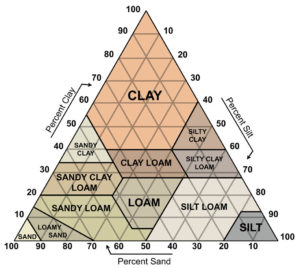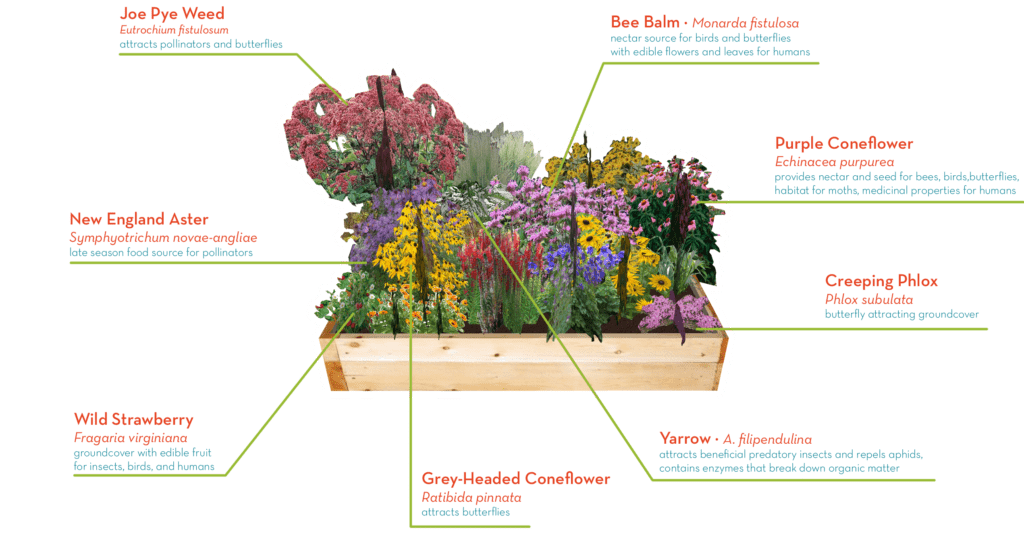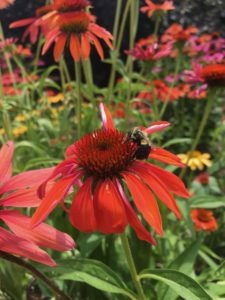Support Your Local Pollinators – and they will support you!

With so much of the land occupied by human development, many of our native flora and fauna are threatened by lack of habitat and adequate food sources, (not to mention climate change). The way people tend to create gardens is a somewhat outdated (colonial) imposition of our will onto the landscape. We often choose plants that serve only an aesthetic imperative, without considering the roles plants play within the surrounding ecosystem. In order to preserve biodiversity in our communities and within the (sub)urban landscape, we need to create habitats for the local wildlife populations and make the most of public spaces like rooftops, parks, office buildings and privately-owned spaces such as our own backyards.
A great place to start is by planting a pollinator garden with locally sourced native plants which form important symbiotic associations with insects, birds and mammals. Some insects need specific plants as their larval host or food source, and more often than not, non native plant species cannot fulfill these crucial roles. The beautiful Eastern Black Swallowtail butterfly lays her eggs on members of the carrot family (Umbellifers) so when her larvae hatch they have a food source that meets their needs.

The more we understand the relationships between plants and their pollinating partners, the better able we are to create and preserve dwindling native grasslands, forests, and wetlands in Ontario. Imagine how much healthier our ecosystem would be if instead of swaths of alien grasses that are foreign to our pollinators, we had an abundance of pollinator-friendly plants in our urban spaces.
With that being said, it can be challenging to plan a garden for the first time, especially when approaching your design with a conservationist rather than with purely aesthetic frame of mind. It may seem complicated to get started but here I break down six digestible steps that highlight some of the most important considerations.
Step 1: Determine Shape, Size and the Orientation of Your Garden Bed.
Which way is North? What is the area of the bed? It helps to make a little sketch for your reference, to aid you in your planning process. Is it a raised garden bed or in-ground?
Step 2: Track and Estimate Your Sunlight Conditions.
Try and estimate the quality and duration of sunlight your garden receives during the day. This will shift over the seasons. Based on the tree canopy, surrounding buildings, or other factors that may block sunlight at different times of day, try and make a rough estimate of the quality of your garden’s sunlight. It helps to make a sketch. Do you notice you get morning sun, afternoon sun, full sun, dappled shade or full shade? Make note of your observations. This will end up affecting the types of plants you will choose. Also, when you get to arranging your plants, make sure the tallest ones will not overshadow smaller ones.
Step 3: Choose Appropriate Plants for Your Soil Texture and Moisture Conditions.

Next, you will want to determine the type of soil you have. Is it loose and sandy, compacted clay or somewhere in between? This is more important if your garden bed is in-ground. If you are unsure, you can search online for how to do your own soil texture test. Even by adding organic soil amendments, you will not be able to significantly change the underlying soil composition, and some plants are choosy about soil texture and water needs. However, many plants are quite adaptable. Plants that may have an extensive range of habitat tend to adapt more successfully when the seed source is local. Another benefit of using plants adapted to your local conditions is that you may end up having to use less water.
Step 4: Promote Biodiversity Whenever Possible.
Ask yourself what kind of pollinators you are looking to support. Do you want to see butterflies, a variety of native bees, hummingbirds or other birds? Plants form associations with particular pollinators and other wildlife. That can be as a larval host, a nectar or pollen source, for nest material, and so forth. Another thing you can do is leave a designated grass-free and mulch-free space somewhere in your garden to provide a nesting site for ground-dwelling bees.

Whenever possible, choose locally sourced organic seedlings or seeds. Also, although I am preaching to the choir here, please avoid using any chemical fertilizer or insecticides in your garden. This is antithetical to the goal.
There are a number of helpful online resources on the native plants of Southern Ontario and the GTA. I will list a few links at the bottom of the page.
Step 5: Plan For Continual Blooms Throughout the Seasons.
The online resources provide information on bloom seasons of various native plants. The David Suzuki website has a very comprehensive chart which I recommend looking at. The local wildlife requires food sources throughout the seasons, such as nectar, pollen or seeds. In addition to these food sources, caterpillars and some other insects also require specific plants as larval hosts. Birds might require shelter from predators or material for their nests. Useful plants include grasses or sedges and a variety of flowering plants.
Step 6: Have fun with Colour and Texture.
Here is the part where we consider our own aesthetic interests. Once you have identified a number of plants that you think can thrive in your space, and you have ensured you have some that bloom in spring, summer and fall, you can choose varieties that add to the visual interest of the garden. Some blooms are tall and vibrant while others can be more subdued and bushy.
Consider texture, height and colour throughout the seasons and experiment (on paper) until you find an arrangement that works.
To aid in your research on native pollinators and appropriate plant choices for your pollinator garden, I recommend looking up native plant nurseries near you, and checking out the following web pages and the resources available at your local library.
We love planning and designing gardens that attract and support pollinators so if planning and designing is not your thing, feel free to get in touch with us. We’re happy to plan a garden for you that will suit you, and your pollinators’ needs.
Resources
- David Suzuki.org – Attract Butterflies with Native Plants- Eastern Canada
- Ontario Native Plants
- Ontario Wildflowers
- Pollinator.org
Monarch butterflies drinking nectar of Joe Pye Weed in BUFCO’s Lab
Posted in
Tags
Comment
Comments are closed.

This blog is so concentrated and nice!